 CLOUD
CLOUD
 CLOUD
CLOUD
 CLOUD
CLOUD
Tempest Inc., a startup that helps developers manage technical resources such as databases, launched today with $3.2 million in seed funding.
Abstract Ventures led the round. It was joined by Box Group, Background Capital and several angel investors including Instacart Inc. co-founder Max Mullen.
San Francisco-based Tempest is led by Chief Executive Officer Ken Kouot. He previously co-founded Fleetsmith Inc., a provider of device management software that Apple Inc. bought in 2020. Tempest’s two other co-founders, Lukasz Jagiello and Eric Skram, also worked at Fleetsmith before the acquisition.
Software teams require various technical resources to carry out their work. For example, a developer wishing to speed up a slow database may require an observability tool that can troubleshoot performance issues. Meanwhile, a colleague working on a new feature for an e-commerce app may wish to create a copy of the app and use it to test the update.
Developers historically required help from the information technology team to deploy such resources. The reason is that a new software tool or infrastructure asset must meet a long list of requirements before it can be added to a company’s network. Administrators must ensure, among others, that it’s secure and complies with regulations.
Tempest has built an IDP, or internal developer platform, that promises to ease the task. It allows administrators to create rule sets called receipts that define how software components and other technical resources should be set up. Developers, in turn, can provision those resources in a few minutes through a self-service portal. This arrangement removes the need for the IT department to manually process every resource deployment request.
Tempest makes it possible to create several kinds of resource deployment workflows. Some help developers provision open-source tools such as OpenTelemetry, which is used to collect error data from applications. Other recipes automate the task of setting up databases and cloud services.
IT teams can also develop recipes that launch multiple resources at once. An administrator could, for example, develop a workflow that sets up a database and a gateway configured to block malicious requests to the database.
Tempest provides the ability to customize the technical resources it launches. Depending on a project’s requirements, administrators can specify whether a resource should be deployed on a company’s production infrastructure or in an isolated test environment. It’s also possible to automatically delete resources after they’re no longer needed.
“Take a simple feature deployment: when your engineers spend three days wrestling with CI/CD pipelines instead of shipping customer value, that’s not just lost engineering hours — it’s delayed revenue and missed market opportunities,” Kouot said. “At Tempest, we’re giving developers the foundation they need to deliver innovation at the speed your market demands.”
Tempest’s platform faces competition from several existing IDP tools. One of the most popular applications in the category is Backstage, which Spotify AB released under an open-source license in 2020. Tempest says competing tools take months to set up in some cases whereas its platform can be deployed in a few hours.
Support our mission to keep content open and free by engaging with theCUBE community. Join theCUBE’s Alumni Trust Network, where technology leaders connect, share intelligence and create opportunities.
Founded by tech visionaries John Furrier and Dave Vellante, SiliconANGLE Media has built a dynamic ecosystem of industry-leading digital media brands that reach 15+ million elite tech professionals. Our new proprietary theCUBE AI Video Cloud is breaking ground in audience interaction, leveraging theCUBEai.com neural network to help technology companies make data-driven decisions and stay at the forefront of industry conversations.